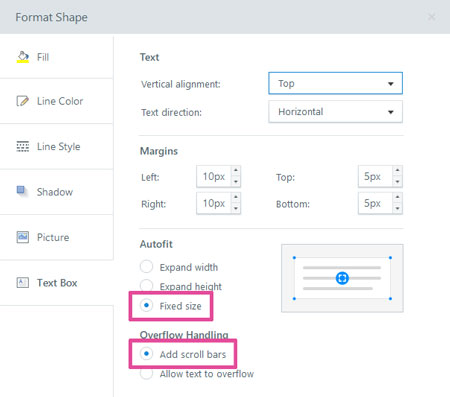Electronic Accessibility
Scrollbars in Storyline
Last updated: 5/26/2025

At this time, it's recommended that scrollbars not be used within Storyline eCourses due to inconsistent and unpredictable behavior encountered by screen reader users when they tab navigate through a slide. This includes scrollbars that occur as a result of using the Fixed size and Add scroll bars settings (within the Text Box tab of the Format Shape panel) and scrollbars that are added through the Insert > Scrolling Pane feature.
Typically, when a screen reader user tabs focus to a section of a web page that uses its own scrollbar, the screen reader will read whatever is at the top of that section.
Currently, that is not the behavior screen reader users encounter in Storyline eCourses; instead, they may experience the following:
- Scrollbars that occur as a result of using the text box Fixed size and Add scroll bars settings: JAWS may read the last element in the scrolling section, while NVDA may announce the scrollbar as "blank"
- This behavior inhibits a screen reader user's ability to reliably understand what it is their screen reader is reading and where that element is within the environment, relative to other elements — these alone could be considered reasons to avoid using scrollbars
- Scrollbars that are added through the Insert > Scrolling Pane feature: JAWS and NVDA may toggle screen reader modes when tab focus lands on a scrolling pane, with subsequent up/down arrow keypresses controlling the scrolling pane, not the screen reader, until the user tabs to the next element or manually toggles the screen reader mode
- While this is not inherently undesirable behavior, it's behavior that should probably be described to screen reader users before they encounter it
Additionally, JAWS and NVDA may encounter the scrolling section's contents at the very end of the slide's tab order, regardless of where that content is actually positioned within the slide's focus order. This could confuse or disorient screen reader users and may be reason enough, on its own, to avoid using scrollbars.
If you must use scrollbars
Try using layers instead of scrollbars, but if for some reason you must employ scrollbars, it's recommended that you:
- Test the scrollbar behavior thoroughly
- Test in multiple web browsers
- Test using as many different screen readers as possible, including on mobile devices
- Test reading linearly through a slide, using tab navigation and using structure-specific screen reader commands
- Provide screen reader users with a description of the scrollbar behavior they'll encounter before they encounter it
